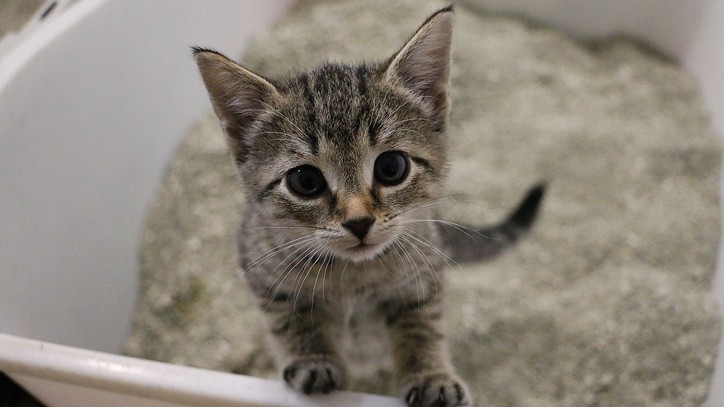How to fix three common kitten behavior problems
While kittens are often regarded as a low-maintenance pet, kitten behavior problems can (and do!) occur

When you bring home your fluffy, cuddly kitten from the animal shelter or breeder, kitten behavior problems are likely the last thing on your mind. In fact, in most cases, behavior shouldn’t be a significant concern! A large number of kittens take readily to a diet of highly nutritious kitten food, litter boxes, toys and other aspects of life with humans.
In some cases, however, kittens may have undesirable behaviors that need to be addressed. This doesn’t indicate a problem with the kitten; it simply indicates the need to invest a bit of effort in order to acclimate the kitten to what is expected in order to live in your home. Read on to learn how to address common kitten behavior problems.
1. Play aggression
Young kittens are typically sweet and cuddly. They may be playful, but their play is typically gentle and is quickly replaced by snuggling. As kittens reach four to six months of age, however, they go through a developmental phase in which their play becomes a bit more rough. This rough play may even cross the line into play aggression, in which the kitten becomes so excitable during play that she will bite or scratch her owners.
While many kittens grow out of play aggression with age, there are simple steps that you can take to help encourage the resolution of this issue. First, ensure that your kitten is receiving enough play to burn off excess energy! Schedule several play sessions per day with your kitten, using a variety of toys to determine which ones help incite her interest.
Next, look for other opportunities to increase exercise during the day. For example, instead of feeding meals out of a bowl, consider using a puzzle feeder to increase your kitten’s activity level. Doc and Phoebe’s Indoor Hunting Feeder (This feeding system provides an outlet for your cat’s natural urges to hunt, providing an outlet for your cat’s energy and instincts while also delivering measured portions of food throughout the day.) is specifically designed to mimic natural hunting behavior in indoor cats, serving as an outlet for some of that excess feline energy!
Finally, encourage appropriate play. If your kitten begins to bat at your hands or feet during play, redirect her attention by using a teaser toy (dangling toy at the end of a long wand), ball, or other item that encourages more distant play. Too often, cat owners tolerate biting and scratching during play for so long that it becomes a habit that is hard to break as the cat becomes larger and can inflict more damage. Instead, work to eliminate these behaviors from a young age and replace them with positive play.
2. Inappropriate elimination
If your kitten is urinating or having bowel movements outside of the litter box, the first step is a veterinary visit. Your veterinarian will perform a thorough exam and additional testing to make sure that your kitten’s poor litter box habits are not caused by intestinal parasites, a urinary tract infection, or another medical issue.
Get the best advice, tips and top tech for your beloved Pets
Once medical causes have been ruled out, the next step is to focus on litter box access. Ensure that your kitten’s litter box is in a convenient, easily accessible location. Although it may be tempting to place the litter box in your basement or another out-of-the-way area of your home, a young kitten may not have the control to make a long trek to the litter box in the middle of an exciting play session. Locating the litter box in an area that’s quiet but convenient will maximize the chances that your kitten uses the litter box appropriately. Make sure that your kitten can easily climb in and out of the litter box; some high-sided boxes that are designed to prevent spillage may be too tall for small kittens to easily access.
If you’re confident that the litter box is easily accessible, take some time to examine the litter itself. Focus on cleanliness, because many cats are hesitant to use a dirty litter box. Are you scooping the litter daily? Are you performing a complete litter change and scrubbing the litter box approximately once weekly? If not, begin doing those things immediately and see whether the problem resolves, also take a look at our guide to the best cat litter for more information. If you continue to have issues, consider trying a different type of litter. Dr. Pam Johnson-Bennet of Cat Behavior Associates states “in general, the best choice for a kitten is one of the soft, scoopable types.” The solution to your problem may be as simple as buying another brand of litter.
If your kitten has an accident outside of the litter box, avoid using punishment. This strategy can backfire, making your kitten more fearful of you and even more fearful of eliminating. Instead, look at the factors that may have contributed to the accident and aim to correct these factors, if possible.

3. Furniture scratching
Wondering, 'Why does my cat scratch the walls?' Scratching is a normal behavior for cats. They scratch to mark their territory, when stretching, when playing, and in numerous other circumstances. Unfortunately, knowing that scratching is normal and healthy is a small consolation when the scratching is damaging your furniture or other belongings!
Provide your cat with a number of scratching posts and other acceptable scratching surfaces, we’ve listed a variety in our guide to the best cat scratching posts. Buy a variety of scratching posts, until you can figure out your kitten’s preferred surface for scratching. Some cats prefer a vertical scratching post, while others prefer scratching on horizontal surfaces. Some prefer to scratch on carpet, while others prefer sisal, corrugated cardboard, or other materials. Be prepared for some trial and error, until you figure out your cat’s preferred scratching surface. If necessary, use catnip or other cat attractants to make the scratching post more appealing.
In addition to providing a suitable scratching post, you will also want to limit your cat’s ability to scratch your furniture and belongings. If possible, move these objects to another area, behind a closed door. If this isn’t an option, consider using double-sided tape or other materials to make these objects less rewarding to scratch, while also placing a tempting scratching post nearby.
Be consistent
When you encounter a behavior problem with your kitten, the most important thing is to be consistent in working towards a solution. We all tend to start strong when it comes to correcting a problem, then become a little bit bored or lazy over time. While this is human nature, it isn’t the best way to tackle kitten behavior problems. Instead, commit to guiding your kitten’s behavior from an early age, in order to ensure that the rest of your cat’s life with your family goes as smoothly as possible.
For more in-depth information on specific issues you’re likely to encounter in your first year as a pet parent, we recommend starting with ‘why is my kitten crying’ to understand some of the potential causes of this common behavior.
Dr. Barnette is a graduate of the University of Florida, where she received both her B.S. in Zoology and her Doctor of Veterinary Medicine (DVM). She has 15 years of clinical experience as a small animal veterinarian, treating dogs, cats, and occasional exotic patients. She now works as a freelance veterinary writer, creating educational content for veterinarians, veterinary team members, and dedicated pet owners. Dr. Barnette lives in southwest Florida with her husband and daughter (plus two cats, a dog, and a rescued dove!) and enjoys kayaking, biking, and hiking. Learn more about Dr. Barnette at www.linkedin.com/in/catherinebarnette.

